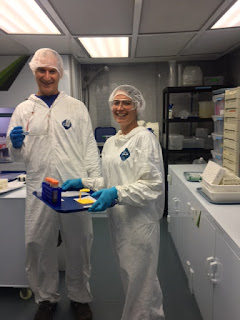The marine scientists among us had to go to Paris to present at a conference. We all drove together to Tel Aviv, Steve took Kim and Esra to the airport, and I went to the
Eretz Israel Museum. I had already toured the Tel Aviv Art Museum, and the Eretz Museum was actually open on a Saturday. (Most stores and restaurants close for Shabbat, busses and trains stop running.)
To my delight, I found that this museum houses all those famous ARTIFACTS from Timna that are published in books! --all those famous fragments of Hathor's face, the Midianite snakes, Egyptian beads... The museum includes a whole hall devoted to Timna.
What I had NOT seen in books, however, were all the fragments of sistrums and meant necklaces, both used by the priestesses of Hathor. So my corpuscles were pulsing!
Why are these fragments so inspiring to me?
Well, I was out there with my own Hathor sistrum, sounding in the desert, thinking I was just enacting some historical fantasy of priestesses at the Hathor temple. Timna is a mining outback. We have no evidence via the art historical record that women mined. And I did not presume that miner men took families to the outback. I had this image in my mind of California gold miners, rugged anti-establishment men out there on their own, lonely but free.
Clearly, though, there WERE women out there, and there WERE priestesses, because fragments of their accoutrements were on proud display at the Eretz Museum! [If you look at my prior posts, too, you will recall that Erez Ben Yosef's University of Tel Aviv's archaeological team found a skeleton with a fetus in the pelvis. We do not know yet, though, if this skeleton was Egyptian, Midianite, Roman, Edomite, Nabatean...]
So if women were part of the community of the mining town of Timna, what did they do there? Did they run households? Were they "career women" as priestesses? Did ordinary women take time out of running households to priestess, too? What is the female story at Timna?
That might be next year's research question!
But here are some sistrum fragments, taken with my cell phone through glass. Data, not art:
And her are some menat necklace fragments. Priestesses of Hathor shook these beaded necklaces like rattles. Women who handled the necklaces were though to hold the power to channel Hathor.
Another hall in the museum was devoted to ceramics. Most of these were Levantine artifacts. I was most enthralled, however, with a collection of Canaanite cultic goddess shrines. I had never seen anything like them. Why not? Well, in Istanbul, wall texts in museums discuss Amazons as fact. In the US, we talk about Amazons as myth. In the US, we like to bury any history that challenges the Christian patriarchal narrative. To reveal it would be dangerous, I suppose. Grrrrrls might take over the Western World if they recalled how powerful women had been, Once Upon a Time. Wouldn't that be awful.
Again, these are from my cell phone through glass, but "as data" rather than "Art"... voila:
Maybe some day I will be able to tie these two things together, Hathor priestesses and Canaanite goddess shrines: Hathor was the only Egyptian deity embraced by the Canaanites. What is that all about? Why did they embrace a goddess of their occupiers? Inquiring minds want to know.
That tambourine that Miriam in the Old Testament played -- could that really have been a Hathor sistrum? How rich a story that would make.
After my museum ecstasy, Steve and I toured the Arab village of Jaffa, which is full of bohemian galleries and cafes. The following days we explored the Arab village of Acre, north of Haifa, and Haifa itself. Acre includes and underground city used by the crusaders. Maybe something got lost in translation, but I was under the impression these crusaders, specifically, were the Knights Templar. (Please fact check before quoting.) Acre also has a souk with TWO music stores. I finally found my Bedouin tunes.
















































